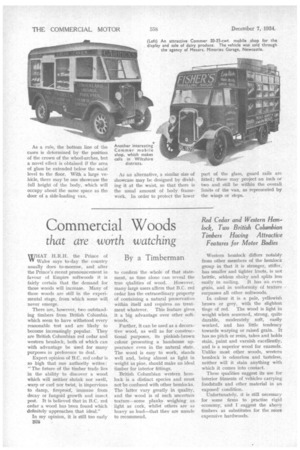Commercial Woods
Page 42

If you've noticed an error in this article please click here to report it so we can fix it.
that are worth watching Red Cedar and Western Hemlock, Two British Columbian Timbers Having Attractive Features for Motor Bodies
By a Timberman
WHAT H.R.H. the Prince of vv Wales says to-day the country usually does to-morrow, and after the Prince's recent pronouncement in favour of Empire softwoods it is fairly certain that the demand for those woods will increase. Many of these woods are still in the experimental stage, from which some will, never emerge.
There are, however, two outstanding timbers from British Columbia which seem to have withstood every reasonable test and are likely to become increasingly popular. They are British Columbian red cedar and western hemlock, both of which can With advantage be Used for many purposes in preference to deal.
Expert opinion of B.C. red cedar is so high that one authority writes : "The future of the timber trade lies in the ability to discover a wood which will neither shrink nor swell, warp or curl nor twist, is impervious to damp, fireproof, immune from decay or fungoid growth and insect pest. It is believed that in B.C. red cedar a wood has been found which definitely approaches that ideal."
In my opinion, it is still too early B2S to confirm the whole of that statement, as time alone can reveal the true qiialities of wood. However, many large users affirm that B.C. red cedar has the extraordinary property of containing a natural preservative within itself and requires no treatment whatever. This feature gives it a big advantage over other softwoods. '
Further, it can be used as a decorative wood, as well as for constructional purposes, its pinkish-brown colour presenting a handsome appearance even in the natural state. The wood is easy to work, stands well and, being almost as light in weight as pine, should make an ideal timber for interior fittings.
British Columbian western hemlock is a distinct species and must not be confused with other hemlocks. The latter vary greatly in quality, and the wood is of such uncertain texture—some planks weighing as light as cork, whilst others are as heavy as lead—that they are unsafe to recommend. Western hemlock differs notably from other members of the hemlock group in that it is stronger, stiffer,' has smaller and tighter knots, is not brittle, seldom shaky and splits less easily in nailing. It has an even grain, and in uniformity of texture surpasses all other softwoods.
In colour it is a pale, yellowish brown or grey, with the slightest tinge of red. The wood is light in weight when seasoned, strong, quite durable, moderately soft, easily worked, and has little tendency towards warping or raised grain. It has no pitch or resin, takes and holds stain, paint and varnish excellently, and is a superior wood for enamels. Unlike most other woods, western hemlock is odourless and tasteless, neither will it stain anything with which it comes into contact.
These qualities suggest its use for interior fitments of vehicles carrying foodstuffs and other material in an exposed condition.
Unfortunately, it is still necessary for some firms to practise rigid economy, and I _suggest the above timbers as substitutes for the more expensive hardwoods.




























































































